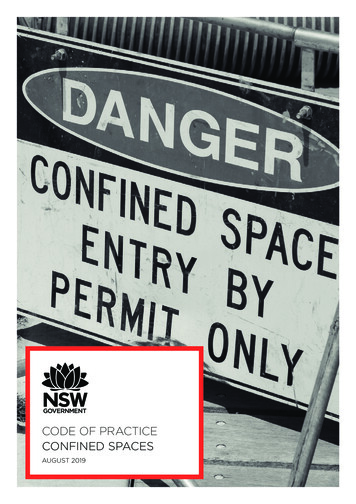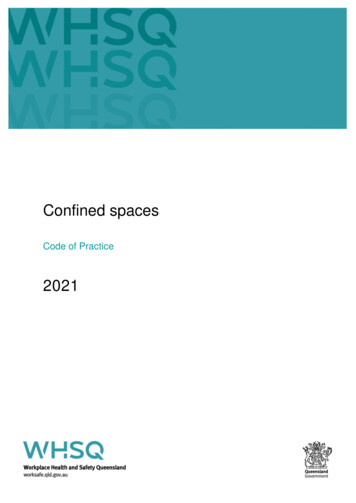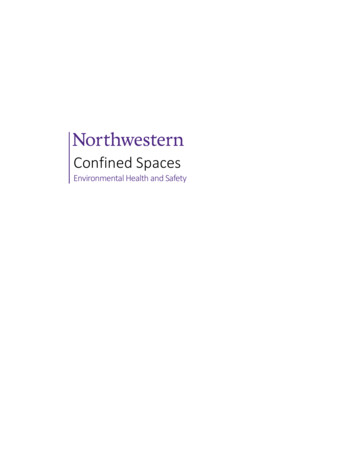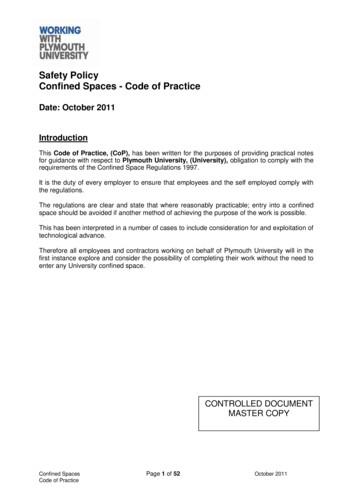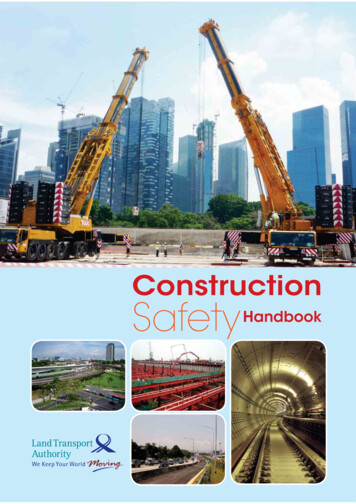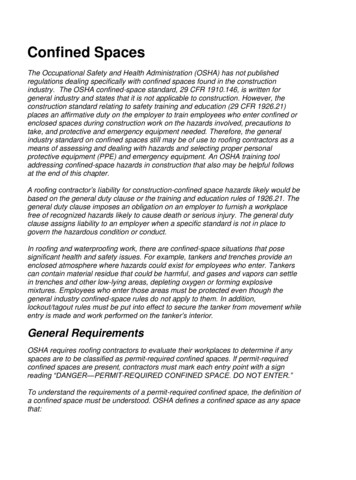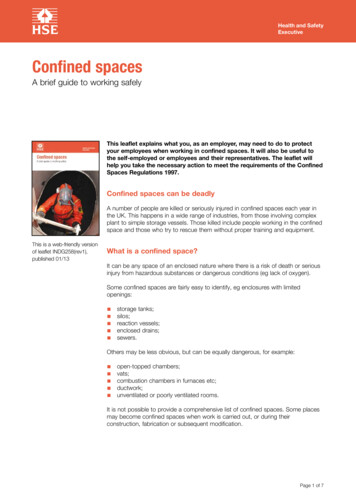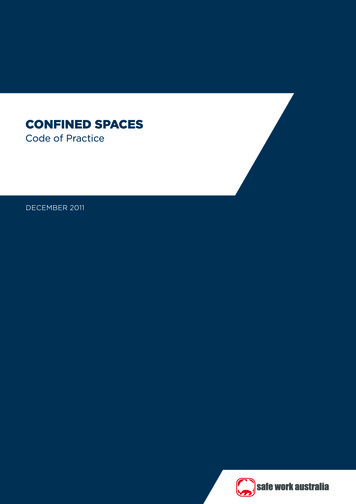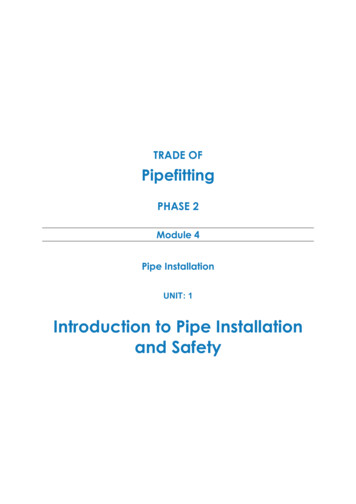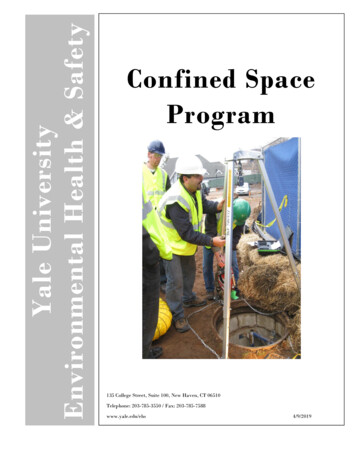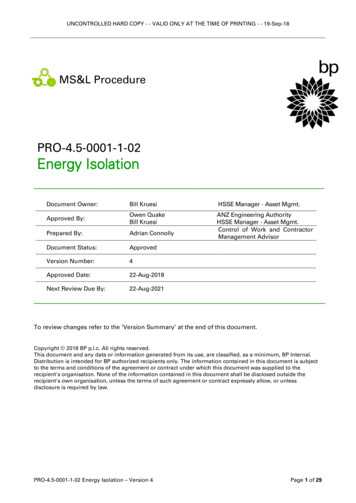
Transcription
CONFINED SPACES IN CONSTRUCTIONPARTICIPANT MANUALVersion III, Revised March 2016
CPWR Student Registration Form(Complete both sides of form)Course Information:Course Type:Date(s):City:State:Course ID #:Student Information:Name:Street Address:City:State:Ph (H):Zip:Ph (C):Email: YesWould you like to receive CPWR emails on construction safety and health issues? MaleSex: White Female Black NoBirth Date (mm/dd/yy): Hispanic// Asian or Pacific IslanderRace: American Indian or Alaskan Native Other:The last 3 digits of your Social Security Number:XXEmployer Name:X–XXAre You An Instructor?Are You A Union Member? Yes No–X Yes No(If Yes, please indicate your craft/trade and local union/district council below) Boilermakers Bricklayers Carpenters Electrical Workers Insulators/Asbestos Workers Ironworkers Laborers Operating Engineers Painters Plasterers/Cement Masons Roofers/Waterproofers Sheet Metal Workers United Association Other (please specify): Local Union/District Council:What resources do you most commonly turn to for the latest health and safety information? (check ( ) up to 3) Union eLCOSH Trade Association Internet Search Government Agency (please circle: OSHA, NIOSH, NIEHS, Other) News Media CPWR Other (please specify):For Trainer/Office Use Only:Pre-Test:Post-Test:Hands-on Training Score:Combined Score:Revised 2016
Question 1: YesHave you ever done work that required you to be certified for hazardous waste? NoIf No, skip and proceed to Question 2If Yes, please list the most recent jobs that required you be certified in hazardous waste:Employer:Employer:City, State:City, State:Type of work:Type of work:Year(s):Year(s):Question 2: Have you ever encountered hazardous waste, soil contamination, or other worksite health hazardsin the course of your work? Yes NoIf No, skip and proceed to Question 3 If Yes, please list the most recent jobs that you encountered hazardous waste or contamination: Employer:Employer:City, State:City, State:Type of work:Type of work:Year(s):Year(s):Please check all that you have been exposed to at work: Contaminated Soil Contaminated Water Beryllium Other hazards (specify): Solvents Confined Spaces Excessive Noise Isocyanates Nanoparticles Welding fumes Lead Silica Dust AsbestosPlease check the personal protective equipment provided to you: Respirator with filters Respirator with air tank or hose Chemical resistant suit Other (specify): Chemical resistant gloves Chemical resistant bootsQuestion 3:Are you about to do work that requires you to be certified in hazardous waste? Yes NoIf No, survey is completeIf Yes, please list the job that requires you to be certified in hazardous waste:Employer:Type of work:City, State:Revised 2016
CPWR Health & Safety Training SurveyThis survey is intended to provide information about the value of health & safety training. At no time will anyrespondent’s identity be linked with any specific answers. Please DO NOT put your name on this survey.Course:Date(s):Location:How many health and safety training courses have you attended?4 5 Please check the box ( ) that best describes you.If a question does not apply, please leave it blank.Always3 Most ofthe time2 Often1 Once ina while0 Never Your Craft/Trade:1a.At your work site, how likely is it for people to stop work if conditions areunsafe? 1b.In the last year, how likely were you to stop work if conditions were unsafe? 1c.Do you feel that health and safety training influenced you?2a.At your work site, do people move from one task to another because of unsafework conditions? 2b.In the last year, how likely were you to move from one task to another becauseof unsafe conditions? 2c.Do you feel that health and safety training influenced you?3a.At your work site, how likely is it for workers to report an unsafe condition tothe foreman? 3b.In the last year, how likely were you to report an unsafe condition to yourforeman? 3c.Do you feel that health and safety training influenced you?4a.At your work site, how likely is it for workers to ask for PPE if they think it isneeded? 4b.In the last year, how likely was it for you to ask for PPE if you thought it wasneeded? 4c.Do you feel that health and safety training influenced you?5a.At your work site, how likely is it for workers to ask to see an MSDS relating tomaterials they are working with or around? 5b.In the last year, how likely was it for you to ask to see an MSDS relating tomaterials you were working with or around? 5c.Do you feel that health and safety training influenced you?6a.At your work site, how common is it for workers to ask for monitoring of aconfined space before entering? 6b.In the last year, how likely was it for you to ask for monitoring of a confinedspace before entering? 6c.Do you feel that health and safety training influenced you? Yes Yes Yes Yes Yes Yes No No No No No NoThe labor educators and health & safety researchers at CPWR THANK YOU VERY MUCH for your time and cooperation.Revised January 2012
DO YOU HAVE A STORY TO TELLABOUT WORKING IN CONSTRUCTION?Either about a problem that occurred in the past that might have beenprevented if you had safety and health training, or a problem that hasbeen solved or an accident averted because you had training? If so,please provide your name, e-mail and phone number, so that we maytalk with you and hear your experiences.Name:Email:Phone:Note to Instructor:Please include completed forms with course paperwork to be submitted to CPWRCPWR - The Center for Construction Research and Training8484 Georgia Avenue Suite 1000 Silver Spring, MD 20910(301) 578-8500 FAX (301) 578-4190
Sample Confined Space Entry PermitsThe following 3 fill-in-the-blank confined space entry permits can bemodified to fit your particular entry. Make sure you use only theappropriate portions of the forms to create your own entry permit.You can also design your own entry permit. You’re not required touse the fill-in-the-blank entry permits provided here.
CONFINED SPACE ENTRY PERMITSample 1Date:Site location or description:Purpose of entry:Supervisor(s) in charge of crews:Type of crew (welding, plumbing, etc)Phone #:Permit duration:Communication procedures (including equipment):Rescue procedures (also see emergency contact phone numbers at end of form):REQUIREMENTS COMPLETEDDATETIMEREQUIREMENTS COMPLETED(Put N/A if item doesn’t apply)(Put N/A if item doesn’t apply)Lockout/De-energize/Try-outSupplied Air Respirator (N/A ifalternate entry)Line(s) Broken-Capped-BlankRespirator(s) (Air Purifying)Purge-Flush and VentProtective ClothingVentilationFull Body Harness w/ “D” ringSecure Area (Post and Flag)Emergency Escape Retrieval EquipLighting (Explosive Proof)LifelinesHotwork PermitStandby safety personnel (N/A ifalternate entry)Fire ExtinguishersResuscitator—Inhalator (N/A ifalternate entry)DATEAdd other specific information, if needed, or attach additional instructions or requirements. See the followingexamples in bold print.Line(s) to be bled/blanked:Ventilation equipment:PPE clothing:Respirator(s):Fire extinguisher(s):Emergency retrieval equipment:TIME
CONFINED SPACE ENTRY PERMITSample 1 (continued)AIR MONITORINGSubstance MonitoredPermissible LevelsTime monitored (puttime)Record the timePercent Oxygen19.5% to 23.5%LEL/LFLUnder 10%Toxic 1:PELSTELToxic 2:PELSTELToxic 3:PELSTELToxic 4:PELSTELMonitoring ResultsREMARKS:Air Tester NameID#Instrument(s) UsedModel # or TypeSerial# or Unit(For example: oxygen meter,combustible gas indicator, etc.)ATTENDANTS AND ENTRANTSAttendant(s)ID#Confined Space Entrant(s)ID#(Required for all confined space work exceptalternate entry)REMARKS:SUPERVISOR AUTHORIZATION - ALL CONDITIONS SATISFIEDDepartment or phone number:EMERGENCY CONTACT PHONE NUMBERS:AMBULANCE:FIRE:SAFETY:RESCUE TEAM:OTHER:
CONFINED SPACE ENTRY PERMITSample 2Date and time issued:Job site/space I.D.:Equipment to be worked on:Standby personnel:Date and time expires:Job supervisor:Work to be performed:1. Atmospheric Checks:Time:Oxygen%Explosives%L.F.M.ToxicPPM2. Tester's signature:3. Source isolation (No Entry):Pumps or lines blinded, disconnected, or blocked:4. Ventilation modification:N/AYesNo N/AYesNoMechanical: Natural Ventilation only: 5. Atmospheric check after isolation and ventilation:Oxygen:Explosive:Toxic:%% L.F.M.PPM 19.5% 10% 10PPM H2STime:Tester's signature:6. Communication procedures:
CONFINED SPACE ENTRY PERMITSample 2 (continued)7. Rescue procedures:8. Entry standby and backup persons successfully completed required training?Is it current?9. Equipment:YesNo N/AYesNoDirect reading gas monitor-tested: Safety harnesses and lifelines for entry and standby persons: Hoisting equipment: Powered communications: SCBA’s for entry and standby persons: Protective clothing: All electric equipment listed:Class I, Division I, Group D and non-sparking tools10. Periodic atmospheric tests:Oxygen% TimeOxygen% TimeOxygen% TimeOxygen% TimeExplosive% TimeExplosive% TimeExplosive% TimeExplosive% TimeToxic% TimeToxic% TimeToxic% TimeToxic% TimeWe have review the work authorized by this permit and the information contained here. Written instruction andsafety procedures have been received and are understood. Entry cannot be approved if any squares aremarked in the “No” column. This permit not valid unless all appropriate items are completed .Permit prepared by:Entry SupervisorApproved by:Unit SupervisorReview by:Operations ManagerThis permit is to be kept at the job site. Return this job site copy to the unit supervisor following job completion.Entrants NameSign inSign outSign inSign out
CONFINED SPACE ENTRY PERMITSample 3PERMIT VALID FOR 8 HOURS ONLY. ALL PERMIT COPIES MUST REMAIN AT THE SITE UNTIL JOB IS COMPLETED.Date:Site location /description:Purpose of entry:Supervisor (s) in charge of crewsType of CrewTelephone #Communication procedures:Rescue procedures (telephone number at bottom):BOLD INDICATES MINIMUM REQUIREMENTS TO COMPLETE AND REVIEW PRIOR TO ENTRYNote: For Items that do not apply, enter N/A in the blank.REQUIREMENTS COMPLETED DATETIMEREQUIREMENTS COMPLETEDTIMEFull Body Harness w/"D" RingLockout/De-energize/TagoutPurge-Flush and VentEmergency Escape RetrievalEquipmentLifelinesVentilationFire ExtinguishersSecure Area (Post and Flag)Lighting (Explosive proof)Breathing ApparatusProtective ClothingResuscitator - InhalatorRespirator(s) (Air Purifying)Standby Safety PersonnelBurning and Welding PermitLine(s) Broken-Capped-BlankContinuous Monitoring:DATE Yes NoPeriodic Monitoring Frequency:Test(s)Permissible entry levelPercent of oxygen19.5% TO 23.5%Lower flammable limitUnder 10%Carbon monoxide 35 PPMAromatic Hydrocarbon 1 PPM *5 PPMHydrogen Cyanide(Skin)Hydrogen SulfideSulfur DioxideAmmonia 10 PPM *15 PPM 2 PPM *5 PPM* 35 PPM*4 PPM* Short-term exposure limit: Employees can work in the area up to 15 minutes. 8 hour Time Weighted Average: Employees can work in the area 8 hours (longer with appropriate respiratory protection).REMARKS:
CONFINED SPACE ENTRY PERMITSample 3 (continued)GAS TESTER NAME & CHECK #:INSTRUCTIONS USED:MODEL &/OR TYPE:SERIAL &/OR UNIT #:SAFETY STANDBY IS REQUIRED FOR ALL CONFINED SPACE WORKSAFETY STANDBY PERSON(S)CONFINED SPACE ENTRANT(S)SUPERVISOR AUTHORIZATION - ALL CONDITIONS SATISFIED:Department or phone number:EMERGENCY CONTACT PHONE NUMBERS:Ambulance:Fire:Safety:Gas coordinator:CHECK#CHECK #
CPWR Trainee Course Evaluation FormCourse:Date(s):Location:Please check the appropriate box ( ) after each question.RarelyThe instructor(s):Most ofthe timeAlways1.Described the course and lesson objectives clearly. 2.Explained how the course content applies to my job or trade. 3.Presented the material clearly, so that I could understand it. 4.Kept the class focused on the important points. 5.Reviewed key points. 6.Gave helpful feedback to the class on the exercises and activities. 7.Made good use of the student materials / manuals. This course helped me to improve my ability to:VerylittleSomeA lot8.Understand the problems of working with hazardous materialsor conditions. 9.Recognize health hazards on the job. 10.Recognize unsafe work conditions and practices. 11.Recognize signs and symptoms that may be related to chemicalexposure. 12.Size up whether a job hazard needs me to take immediate action. 13.Use protective equipment. 14.Understand my legal rights. 15.Understand the importance of site safety plans and emergencyresponse planning. Please turn over to complete side 2 Revised January 2012
Teaching methods and materials:Information in this course was delivered in several different ways. CPWR would like to know how well each of thesemethods contributed to helping you learn what you needed to know. If any of these methods or materials were notused, please mark n/a for that question.n/aDidn’thelp at allHelpedsomeReallyhelped16.Lectures 17.Discussions 18.Demonstrations 19.Class exercises 20.Hands-on activities / simulations 21.Course manual 22.Slides / PowerPoint presentations 23.Video / CDROM / DVD 24.Other: Not at all25.Overall, how well did this class meet the objective of helping you todevelop the knowledge, skills, and confidence you need to work safelyat hazardous waste sites after you receive site specific training?26.How could this course be improved? Some Completely The labor educators and health & safety researchers at CPWR THANK YOU VERY MUCH for your time and cooperation.Revised January 2012
Answer SheetA B C D E1. F F F F FA B C D E15. F F F F FA B C D E29. F F F F FA B C D E43. F F F F FA B C D E2. F F F F FA B C D E16. F F F F FA B C D E30. F F F F FA B C D E44. F F F F FA B C D E3. F F F F FA B C D E17. F F F F FA B C D E31. F F F F FA B C D E45. F F F F FA B C D E4. F F F F FA B C D E18. F F F F FA B C D E32. F F F F FA B C D E46. F F F F FA B C D E5. F F F F FA B C D E19. F F F F FA B C D E33. F F F F FA B C D E47. F F F F FA B C D E6. F F F F FA B C D E20. F F F F FA B C D E34. F F F F FA B C D E48. F F F F FA B C D E7. F F F F FA B C D E21. F F F F FA B C D E35. F F F F FA B C D E49. F F F F FA B C D E8. F F F F FA B C D E22. F F F F FA B C D E36. F F F F FA B C D E50. F F F F FA B C D E9. F F F F FA B C D E23. F F F F FA B C D E37. F F F F FA B C D E10. F F F F FA B C D E24. F F F F FA B C D E38. F F F F FA B C D E11. F F F F FA B C D E25. F F F F FA B C D E39. F F F F FSCOREA B C D E12. F F F F FA B C D E26. F F F F FA B C D E40. F F F F FWrittenA B C D E13. F F F F FA B C D E27. F F F F FA B C D E41. F F F F FVerbalA B C D E14. F F F F FA B C D E28. F F F F FA B C D E42. F F F F FRead the Following Before You Begin.– Make heavy black marks that completelyfill the circle.– Erase clearly any answers you wish tochange.– Make no stray marks on this answer sheetPlease list allscoresName:Course Location:I.D. #:CPWR - The Center for Construction Research and Training
8484 Georgia Avenue, Suite 1000Silver Spring, MD 20910Phone: 301- 578-8500Fax: 301-578-8572E-mail: elcosh.orgConfined Spaces in ConstructionParticipant ManualVersion 1.0 March 2016Disclaimer: Copyright 2016, CPWR - The Center for Construction Research and Training. All rights reserved.Funding is provided by Cooperative Agreements ES06185 and ES09764 from the National Instituteof Environmental Health Sciences (NIEHS), NIH. The contents are solely the responsibility of theauthors and do not necessarily represent the official views of NIEHS or NIH.Acknowledgements:CPWR would like to thank the following individuals for their contribution to this work:Kelly Dykes; Gary Gustafson; George Newman; Spencer SchweglerParticipant ManualPreface-1
Preface-2Participant Manual
IntroductionCPWR – The Center for Construction Research and Training conducts research andadministers specific types of construction health and safety training for members of ourconsortium partners, and the North American Build Trades Unions. Our overriding goalin all the training we deliver is to enable and empower these construction workers torecognize potentially unsafe working conditions, and to identify proper ways to eliminate orcontrol those hazards that make conditions unsafe.However, this in no way ever relieves the employers from their primary responsibility ofproviding workers a safe and healthful workplace.CPWR developed this sixteen hour confined space program to enable it to teach majorlegal requirements of OSHA’s Confined Spaces in Construction Standard (29 CFR 1926Subpart AA) and Permit-required Confined Space for General Industry (29 CFR 1010.146).According to the Occupational Safety and Health Administration (OSHA), “An employerwhose workers are engaged in both construction and general industry work in confinedspaces will meet OSHA requirements if that employer meets the requirements of 29 CFR1926 Subpart AA - Confined Spaces in Construction.” The Center’s main goal, however, isto ensure that members of the Building and Construction Trades understand what it is towork safely in confined spaces.Every year hundreds workers in the United States die in confined space accidents andseveral thousand are seriously injured. Statistics compiled by the National Institute forOccupational Safety and Health (NIOSH) show that confined space accidents, more thanany other type of workplace emergency, are likely to result in death.One study by NIOSH found that about one-third of the fatalities in the incidents theyinvestigated were would-be rescuers – individuals who tried to save a co-worker who wasin trouble (see “Worker Deaths in Confined Spaces” by Ted A. Petit, et al, 1996). Perhapsa more meaningful statistic from Petit’s article is that only 40% of the employers involvedin the NIOSH study had a written confined-space entry program and none had a confinedspace entry permit system. According to NIOSH:Participant ManualPreface-3
Most accidents involving workers in confined spaces are dueto failure of site supervision to study the potential hazards andto provide appropriate safety and health programs; failure ofsupervisors to follow standard safety operating procedures andenforce regulations; and failure of workers to recognize and takeappropriate action to avoid the effects of the hazards present.(NIOSH Training Resource Manual, 1985)The CPWR Confined Spaces in Construction Course has been designed to be clear, direct,and to involve you actively in the learning process.Learning objectives, found at the beginning of each chapter, tell you what you will beexpected to be able to do after you finish the training: Brief case studies demonstrate the importance of the information and skills taught.The information that you need is stated in clear, non-technical language whereverpossible. Technical or unfamiliar concepts are carefully explained.Classroom lectures, demonstrations, and activities help you to be actively involved inthe learning process and to become confident in your ability to use what you learn.Hands-on workshops give you the opportunity to practice putting on, wearing, anddecontaminating protective equipment.Your instructors are always available to explain any material that is not clear.It is CPWR’s goal that every trainee leave the Confined Spaces in Construction course withthe basic skills, knowledge and confidence that he or she needs to work safely in confinedspaces, and that they will be better able to protect themselves on all their jobs. With youractive participation, we are confident that we will meet that goal.WARNINGThe material was prepared for use by experienced instructors in the training of persons whoare or who anticipate working in confined spaces. Authors of this material have prepared itfor the training of this category of workers as of the date specified on the title page. Usersare cautioned that the subject is constantly evolving. Therefore, the material may requireadditions, deletions, or modifications to incorporate the effects of that evolution occurringafter the date of this material preparation.Preface-4Participant Manual
DISCLAIMERThe Occupational Safety and Health Administration (OSHA) rule to help assure workerhealth and safety in confined spaces requires introductory, general training on basichazard recognition, use of provided protective equipment, basic isolation procedures, selfrescue, entrant/attendant and entry supervisor roles and responsibilities and other relevantstandard operating procedures, as well as training at each site. This program is intendedto meet the requirements of the introductory, general training. It must be followed by sitespecific training, during which the specifics of the locations of confined spaces and permitrequired spaces, protective equipment, and other procedures and information at the site arediscussed and practiced. At that time, the elements of the site-specific standard operatingprocedures are given in detail. Additional site-specific training for emergency responsemust be provided so that you understand how to recognize and respond to alarms at thesite and can carry out any role which may be assigned during a response.For information about further training, consult the training instructor, your company safetyand health plan, your company health and safety representative, or your union health andsafety representative.Participant ManualPreface-5
Preface-6Participant Manual
Table of ContentsChapter 1: Properties & Definitions of Confined Spaces1-1Chapter 2: Atmospheric Hazards of Confined Spaces2-1Chapter 3: Air Monitoring3-1Chapter 4: Personal Protective Equipment &4-1Communication Equipment for Confined SpacesChapter 5: Isolating the Permit Space for Entry5-1Chapter 6: Ventilating Confined Spaces6-1Chapter 7: Entrants, Attendents & Supervisors7-1Chapter 8: OSHA Permit System and the Entry Permit8-1Chapter 9: Retrieval & Rescue From Confined Spaces9-1Chapter 10: OSHA Standards for Confined SpaceGlossary:Participant Manual10-1G-1Preface-7
Preface-8Participant Manual
Confined Space Worker TrainingProperties & Definitions of Confined SpacesChapter 1: Legal Rights & ResponsibilitiesChapter 1: Properties & Definitions of Confined SpacesEach year in the United States, approximately 100 workers die in confined spaces;many more are seriously injured. Every single one of these deaths and injuriesis preventable. This chapter looks at the OSHA regulations dealing with confinedspaces in construction and general industry and identifies common properties ofconfined spaces and their hazards. It also explains how OSHA regulates confinedspaces in the Confined Spaces in Construction Standard and where appropriate,compares it with the Permit-Required Confined Space for General Industry.Chapter Objectives:After completing this module, you will be able to:1. Define a confined space, giving three characteristics.2. List two categories of confined spaces and give examples of each.3. List two factors that lead to fatal injuries in confined spaces.4. Describe the four characteristics of a permit-required confined space.5. Explain the employers responsibilities under 1926 Subpart AA ConfinedSpaces in Construction.Participant Manual1-1
Confined Space Worker TrainingProperties & Definitions of Confined SpacesThe Confined Spaces in Construction standard (29CFR 1926.1200-1213) appliesto construction work performed in confined spaces, except for certain constructionactivities that are subject to confined space provisions in other OSHA constructionstandards. The activities excluded from this standard are: Diving – regulated by 29 CFR Part 1926 subpart Y. Excavations – regulated by 29 CFR Part 1926 subpart P. Underground Construction, Caissons, Cofferdams and Compressed Air –regulated by 29 CFR Part 1926 subpart S.OSHA’s standard for confined spaces in general industry (29 CFR 1910.146) containsthe requirements for practices and procedures to protect employees in generalindustry from the hazards of entering permit spaces. The General Industry PermitRequired Confined Spaces rule applies to all workplaces and work activities exceptconstruction, agriculture, marine terminals, and ship yards.Whether you work in construction or general industry, the information in this trainingmanual applies to both regulations. According to OSHA, if an employer meets therequirements of the Construction confined space standard than they have also met therequirements of the General Industry Permit-required Confined Space standard.WHAT IS A CONFINED SPACE?A confined space is a space whose configuration and/or contents may presentspecial dangers not found in normal work areas. Such hazards endanger both theworkers in the confined space and others who become exposed to the hazards whenthey attempt to rescue injured workers. In a number of cases, rescue workers havethemselves died or been injured because they did not have the training and equipmentnecessary to conduct the rescue safely.Confined spaces share the following characteristics:1. Is large enough and so arranged that aworker can bodily enter it;2. Has limited or restricted means for entry andexit; and3. Is not designed for continuous workeroccupancy.1-2Participant Manual
Confined Space Worker TrainingProperties & Definitions of Confined SpacesLimited Means of Entry/ExitMany confined spaces have only one opening. Openings are often small, awkwardlyshaped or hard to get to. Some confined spaces, such as pits and excavations,may have large openings but they are difficult and dangerous to enter or exit. Thelimited entry/exit of confined spaces can make escape and rescue difficult. Any of thefollowing factors indicate that a work space has a limited orrestricted means of exit: The need to use a ladder or movable stairs, or stairs thatare narrow or twisted; A door that is difficult to open or a doorway that is toosmall to exit while walking upright; Obstructions such as pipes, conduits, ducts, or materialsthat a worker would need to crawl over or under orsqueeze around; The need to travel a long distance to a point of safety.Not Meant for Continuous Employee OccupancyUsually, people enter confined spaces to inspect, repair, and clean the space itself,the equipment it contains, or to get access to another structure. A confined spacemay be entered every day for a limited period of time or it may be entered only a fewtimes a year. But confined spaces are not designed for full-time, continuous workeroccupancy. A space is not designed for continuous employee occupancy if it is notdesigned with features such as ventilation, lighting, and sufficient room to work andmove about that are needed if people are to occupy it continuously.Confined spaces that may be found on construction sites include, but are not limitedto: Manholes (such as sewer, storm drain,electrical, communication, or other utility) Sewers Storm drains Water mains Lift stations Tanks (such as fuel, chemical, water or otherliquid, solid or gas)Participant Manual1-3
Confined Space Worker TrainingProperties & Definitions of Confined Spaces Pits (such as elevator, escalator pump, valve or other equipment) Bins Boilers Incinerators Scrubbers Concrete pier columns Transformer vaults Heating, ventilation, and air conditioning (HVAC) ducts Precast concrete and other pre-formed manhole units Drilled shafts Enclosed beams Vessels Digesters Cesspools Silos Air receivers Sludge gates Air preheaters Transformers Turbines Chillers Bag houses Mixers/reactors Crawl spaces Attics Basements (before steps are installed).1-4Participant Manual
Confined Space Worker TrainingProperties & Definitions of Confined SpacesNIOSH DefinitionThe National Institute for Occupational Safety andHealth (NIOSH) defines confined space differentlythan the OSHA definition. NIOSH replaces the OSHAstatement, “Is large enough and so arranged that aworker can bodily enter it” with “unfavorable, or poor,natural ventilation” in their definition. Many confinedspaces have poor ventilation because they aredesigned to store, process, and transport materials.Confined spaces may house equipment (utility vaults)or provide access to equipment and structures. Someconfined spaces, digesters for example, are made tobe air-tight. Poor ventilation can lead to low oxygenlevels and high levels of gases and vapors.OSHA’S CONSTRUCTION STANDARDREQUIRES:All employers engaged in construction work must identify any confined spaces inwhich their workers will be working, and determine whether any such spaces arepermit spaces. When workers work in permit spaces, they must be protected againstthe hazards in those spaces. To ensure such protection, the Confined Spacesstandard imposes duties on “entry employers,” “host employers,” and “controllingcontractors.” If your employer knows that a permit space is present at its worksite,they must inform you of the location and danger posed by each space. They may dothis by making sure that warning signs are posted. In addition, where workers have nowork to do in the space, your employer must ensure that you stay out. One way to dothis is for your employer to make sure that you recognize permit space warning signsand understand their significance.Host, Controlling and Entry EmployersA host employer is the employer that owns or manages the property where theconstruction work is taking place. Where the host employer has information aboutpermit space hazards on the site, it must share that information with the controllingcontractor, who is then responsible for sharing it with the other employers on the site.In no case will there be more than one host employer. If the owner of the propertyon which the construction activity occurs has contracted with another employer tomanage the property and provided any relevant information it has abo
confined space before entering? 6b. In the last year, how likely was it for you to ask for monitoring of a confined space before entering? 6c. Do you feel that health and safety training influenced you? Yes No The labor educators and health & safety researchers at CPWR THANK YOU VERY MUCH for your time and cooperation. Revised January 2012
